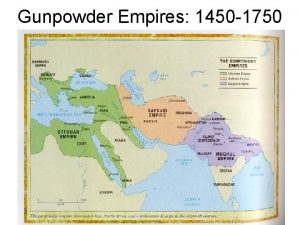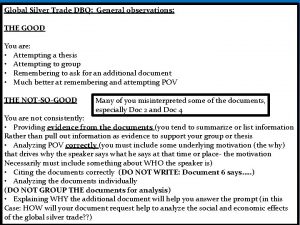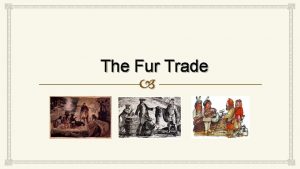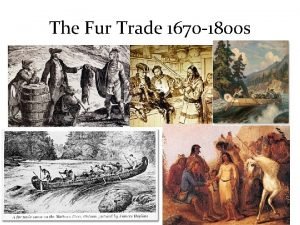Silver and Fur Trade 1450 1750 AP World
















- Slides: 16

Silver and Fur Trade 1450 -1750 AP World History Notes Chapter 15 “Global Commerce”

Silver and Global Commerce � Silver = 1 st major commodity to be exchanged on a truly global scale

Silver and Global Commerce �Mid-1500 s = rich silver deposits discovered in Bolivia and Japan �Spanish America = produced about 85% of the world’s silver �Major link in silver trade = Philippines Silver = mined in Bolivia sent to Acapulco in Mexico where it was loaded onto cargo ships then shipped to the Philippines

Silver and Global Commerce � Most of the world’s silver supply = ended up in China � Foreigners could now purchase indemand Chinese goods with silver Many merchants flocked to Manila (capital of the Philippines) to sell Chinese goods there for silver � Furthermore in 1570 s = China issued new single tax that all people were required to pay in silver Meant that more goods needed to Chinese porcelain in Europe be sold by them = more silver in China = taxes could be paid

Silver and Global Commerce �Besides Chinese goods, silver was also used to purchase: Spices in Southeast Asia Slaves from Africa

Silver: Impact on Spain POSITIVES � Brought wealth and power to Spain � Rulers could now pursue military and political ambitions in Spain and the Americas � Supported the Spanish Empire NEGATIVES � Over time too much silver flowed into Spain caused inflation = value of silver went down and prices went up � When the value of silver dropped worldwide (early 1600 s), Spain began to weaken and lose power

Silver and Japan �Japan put its silver- generated profits to good use: Shoguns used it to defeat Procession of Japanese shoguns in 17 th century rival feudal lords and unify Japan Shoguns worked with merchant class to develop a market-based economy Invested in agricultural and industrial enterprises Protected and renewed Japan’s dwindling forests

Silver and Japan � Simultaneously = millions of families (in 18 th century) took steps to have fewer children � Results for Japan = slowing of population growth; prevention of ecological crisis; bustling, commercialized economy Laid the groundwork for Japan’s Industrial Revolution in the 19 th century

Silver and China � Impact of silver on China’s economy: Led to more commercialization In order to pay silver tax, people had to sell something led to economic specialization ▪ Ex: Selling just rice or just silk � Impact on China’s environment: More land = used to grow cash crops Result = loss of about ½ of China’s forests Chinese women making silk

Fur in Global Commerce � By 1500 = diminished supply of fur-bearing animals in Europe due to population growth and agricultural expansion � “Little Ice Age” = period of cooling temperatures and harsh winters at the time � Result of these conditions = high demand for furs � Result of this demand = pushed prices for furs higher = incentive for traders to sells it

Fur Trade in North America � Fur trade = very competitive � French = in St. Lawrence Valley, around Great Lakes, and along Mississippi River � British = Hudson Bay region and along Atlantic coast � Dutch = along Hudson River (present-day New York)

Fur Trade in North America � Actual hunting, trapping, processing, and transporting of animals/furs = done by Native Americans Brought them to European coastal settlements or trading posts Europeans then sold the furs abroad � In return for the furs, Europeans gave Native Americans: guns, blankets, metal tools, rum, and brandy

Fur Trade in North America: Impact on Native Americans POSITIVES Received items of real value (ex: copper pots, metal axes, etc. ) � Strengthened their relationships with neighboring peoples � Enhance authority of chiefs could give their followers gifts � Protected them (for a while) from enslavement, extermination, or displacement � NEGATIVES Exposure to European diseases Competition between tribes for furs = resulted in conflict and warfare � Often got caught up in European rivalries/conflicts � Became dependent on European goods; never learned to make themselves � Alcohol-related problems resulting from influx of rum and brandy � �

Siberian Fur Trade �Siberia (in Russia) = Transporting furs across Siberia major source of furs for Western Europe and the Ottoman Empire �Brought wealth to the Russian state and many private merchants, trappers, and hunters

Siberian Fur Trade �Consequences for native Siberians: Exposure to new diseases Became dependent on Russian goods Settlers encroached on their native lands Depletion of many species of fur-bearing animals A Russian Sable

Fur Trade North America vs. Siberia NORTH AMERICA � Several European nations competing � Obtained furs using negotiations and trade with Native Americans SIBERIA � Only Russians and native Siberians getting furs � Obtaining furs themselves; no middlemen � Russian authorities imposed a tax (payable in furs) on all Siberian men between 18 and 50 took hostages (who were sometimes executed) if taxes not paid
 Fur trade ap world history
Fur trade ap world history Russian empire 1750
Russian empire 1750 Mughal empire 1450 to 1750
Mughal empire 1450 to 1750 Land based empires 1450 to 1750
Land based empires 1450 to 1750 Japan 1450-1750
Japan 1450-1750 Religion in 1450 to 1750
Religion in 1450 to 1750 Southeast asia 1450 to 1750
Southeast asia 1450 to 1750 Splitski nadbiskup 1450
Splitski nadbiskup 1450 Change analysis chart 1450 to 1750
Change analysis chart 1450 to 1750 Global silver trade
Global silver trade Silver carpet bedroom/silver carpet living room
Silver carpet bedroom/silver carpet living room Zinc silver nitrate gives zinc nitrate silver
Zinc silver nitrate gives zinc nitrate silver Ap world history 600 to 1450 review
Ap world history 600 to 1450 review World map 1450
World map 1450 The changing world output and world trade picture
The changing world output and world trade picture The changing world output and world trade picture
The changing world output and world trade picture Pros and cons of fur trade
Pros and cons of fur trade






























